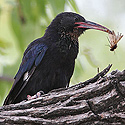|
Family: Phoeniculidae (wood-hoopoes)
Life
> Eukaryotes >
Opisthokonta
> Metazoa (animals) >
Bilateria >
Deuterostomia > Chordata >
Craniata > Vertebrata (vertebrates) > Gnathostomata (jawed
vertebrates) > Teleostomi (teleost fish) > Osteichthyes (bony fish) > Class:
Sarcopterygii (lobe-finned
fish) > Stegocephalia (terrestrial
vertebrates) > Tetrapoda
(four-legged vertebrates) > Reptiliomorpha > Amniota >
Reptilia (reptiles) >
Romeriida > Diapsida > Archosauromorpha > Archosauria >
Dinosauria
(dinosaurs) > Saurischia > Theropoda (bipedal predatory dinosaurs) >
Coelurosauria > Maniraptora > Aves
(birds) > Order: Upupiformes
Species indigenous to southern Africa
|
Phoeniculus
damarensis (Violet wood-hoopoe) The Violet wood-hoopoe's
population is small and localized, with an estimated 1 650 birds scattered
across Namibian and Angolan Mopane woodland. It is mostly insectivorous,
foraging in trees, occasionally dropping to the ground to pick up an insect.
It is a monogamous, cooperative breeder, meaning that non-breeding birds
help the breeding pair with incubation and caring of the chicks. It nests in
tree cavities, laying 4-5 eggs, which are incubated solely by the female.
The chicks are cared for by the female, who is supplied with food hunted by
the male or group members |
 |
|
Phoeniculus
purpureus (Green wood-hoopoe, Red-billed wood-hoopoe)
Common in central and eastern southern Africa, prefering habitats ranging
from arid savanna to valley bushveld and wooded gardens. It forages on
trees, running up and down trunks and branches locating food, usually
insects but also reptiles, amphibians and seeds. It nests in pre-existing
cavities and lays 2-5 eggs, which are incubated for 17-18 days. The chicks
are fed by helpers, as well as the breeding male and stay in the nest for
28-30 days. By 3-4 weeks after leaving the nest, they can fly strongly, and
they are fully independent 2-3 months after fledging. |
 |
|
